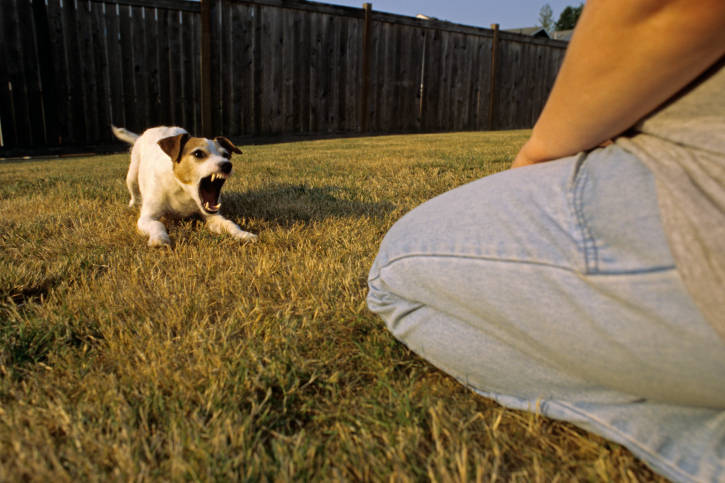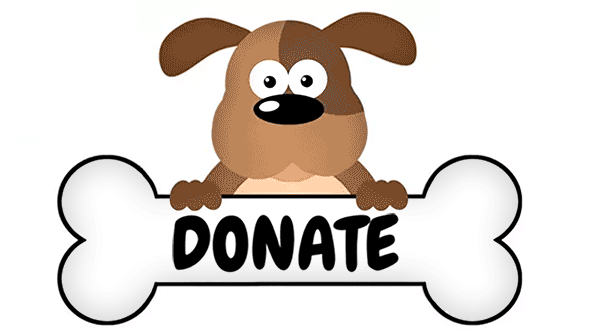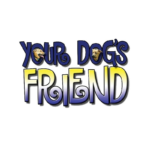 Help! My Dog Barks & Lunges At People!
Help! My Dog Barks & Lunges At People!
This overview will help you understand why your dog acts aggressively toward people and what you can do about it. Since it isn’t specific to your dog, however, you may want to consider working privately with one of the trainers on our referral list.
Your Dog’s Emotional Response
Nearly all reactivity is rooted in fear. Your dog’s aggressive behavior causes people to retreat, and then your dog feels safer. NEVER PUNISH A DOG FOR REACTIVE BEHAVIOR. If you yank on your dog or yell at him to stop, all you have done is reinforce the idea that people make bad things happen. And if you punish your dog for growling, your dog may go straight to biting without a clear warning sign. Your dog is actually giving you important information that can help keep both your dog and other people safe. He is telling you that he is too close to what is making him anxious – in this case, people.
Management
You need to keep your dog away from people he is afraid of while you teach him that people can be trusted and that, in fact, good things happen when people are around. Every time your dog acts aggressively and the person backs off, your dog is more likely to repeat that behavior in the future. After all, IT WORKS.
- When walking your dog, if you see someone ahead, cross the street, turn around, or wait behind a car. Make your walks fun – change speeds, go around obstacles, pivot in different directions – so that your dog is paying attention to you, instead of scanning his environment for danger.
- In your home, don’t bring your dog out when people are over. You and your dog will both feel less anxious.
- Reduce your dog’s arousal level by not permitting fence fighting in your yard and preventing your dog from barking at people outside your home. Use a baby gate to keep your dog out of the room with that big picture window; keep the curtains closed (with pants hangers, if necessary); or cover your windows with Decorative Arts film, available at Home Depot or Lowe’s, that your dog can’t see through, but you can.
- If you have a small dog, recognize that carrying your dog around gives him the confidence and opportunity to snap or bite another person. He’s not actually protecting you; he’s protecting himself.
Changing Your Dog’s Emotional Reaction
Strangers Outside Your Home
Your ultimate goal is to teach your dog to be comfortable around people. You want to change his emotional response from “people are scary” to “people make good things happen”. Work with your dog far enough from strangers that your dog doesn’t react. If your dog does react, you are too close and need to move back. Stay stationary, so that you can maintain a comfortable distance throughout the training. These sessions should be short, but repeated often, moving closer as your dog’s comfort level increases.
When your dog sees a person, start giving your dog tiny treats, one after another. Save the yummiest food for this exercise, so your dog learns “scary person = steak” (or string cheese or turkey hotdogs or whatever else your dog loves). Start the treats when your dog sees the person and stop when the person is gone. If the person is taking too long to move on, you and your dog may need to be the ones to leave. Keep in mind that you are not trying to distract your dog; you are trying to change your dog’s negative association with people.
Don’t move too close too fast. The most difficult part of this exercise is having enough patience to avoid stressing your dog.
Guests in Your Home
Give your dog a safe place to go where he can relax, and let him stay there while there are people in your home. Keep a leash and treats by the door, so you can take him to his safe place when someone shows up unexpectedly. If you know that people are coming over, put your dog in his crate or another room, before they arrive, with a Kong that has been stuffed and frozen with his favorite treats. You can also use an interactive toy, but make sure it’s one that is safe for alone-time.
Try a white noise machine or music to help block out the sounds of company. There is a CD developed specifically to calm dogs that may help – (www.iCalmPet.com.) Some dogs respond to other calming tools: Comfort Zone, a DAP (dog appeasing pheromone) diffuser, which releases an odor like that of a nursing mother; Rescue Remedy, which is a mixture of plant essences; a tight t-shirt, Anxiety Wrap, or Thundershirt to help calm your dog’s nervous system.
People Who Live With You
It can be very disappointing to bring home a new dog and find that the dog doesn’t like your spouse, housemate, or other person living in your home. Moving to a new environment is always stressful, but for some dogs, it’s traumatic. Each person is a new and frightening experience for a dog that has not learned to trust. If this happens, it’s important that this person essentially ignore the dog, not look at him, not reach out to him, etc. That person, however, can be the source of many good things. He could, for example, drop treats when standing up, moving, or being approached by the dog. The person should not toss the treats, since this involves a hand moving toward the dog. People can’t force a dog to trust them, but they CAN show the dog gradually over time that they are safe.
If your dog doesn’t like your child, that’s a more serious issue. If he is reacting to something your child does, like picking up or falling on your dog, that’s one thing. Help your dog escape to a safe place. (See our handout on children & dogs.) But if your child is too young to understand or if your dog just doesn’t like children, this is the wrong home for your dog, and the best thing for your family and your dog, as heartbreaking as it is, is to return him to the shelter or rescue where you got your dog, so he can go to an appropriate home, without children.
Regular Visitors to Your Home
You may have regular visitors, such as relatives, neighbors, or close friends. You want your dog to be comfortable with these visitors and not have to go to his safe place every time they visit. Remember, though, that each of these people, regardless of how close they are to you, is a stranger to your dog. He may not know whether he can trust your best friend or your son-in-law. If your dog’s reaction is relatively mild, you can have your dog on a leash or tether at a safe distance. Give him treats from the moment you hear the car pull up or, if you miss that, the doorbell rings. Keep giving your dog one tiny treat after another while your guest walks through the hall to another room. Your guest should ignore your dog, so that your dog is not pushed beyond his comfort zone. When your dog can no longer see your guest, stop the treats. In your dog’s eyes, this visitor made treats happen and the treats stopped when the person went away.
You can also train your dog to run to his “safe place” for a Kong stuffed with his favorite foods. Practice with a friend who rings the doorbell, while you quickly walk to your dog’s safe room or crate with treats to entice him. Keep a few stuffed Kongs in the freezer to use when needed. Once your dog goes to “his place” easily, add a verbal cue that you will be able to use in the future. Getting your dog away from the door will keep your dog from practicing the barking / lunging behavior and will reduce his arousal level. Giving your dog something he likes at his designated spot will also help him think that your frequent visitors make good things happen.
Remember that one visitor is not the same as multiple visitors. Even if your dog learns to be comfortable around your best friend, your best friend’s family may be more than your dog can handle.
Construction & Maintenance People
Workmen, contractors, and occasional housekeepers are particularly frightening. They dress differently, tend to move fast and purposefully, carry and use strange equipment, and make loud noises. Since they don’t have time to go through a socialization process, put your dog in a safe place before the person arrives. This will help protect against backsliding by your dog and harm to the person.
Keep the Faith
It is extraordinarily rewarding to see a people – reactive dog learn to tolerate, or even welcome, people. Keep a simple record of breakthroughs to refer to when you feel discouraged. It will never be easy, and it may even seem embarrassing, to live with a reactive dog. But you clearly love your dog and want the best for him. So, whatever your dog has been through in the past, your dog is lucky to have you now.
Key Points to Remember:
When working with your dog, keep him at a distance where he can remain calm. If your dog reacts, you are too close. Do not force interaction. It’s best if people let your dog decide if and when to approach.
Management accomplishes two things: It keeps your dog from practicing the behavior, and it helps your dog feel safe.
Reward any time your dog remains calm around people. Keep small containers of treats throughout the house and take a treat bag on walks to ensure there are no missed opportunities.
Be safe. Don’t think that because your dog’s behavior has improved, you can now walk right up to people. If that person moves suddenly, leans over your dog, reaches over to pat his head, or looks him in the eye, your dog may bite to protect himself.
If your dog has bitten someone or would bite if you didn’t prevent it, it’s time to see a professional. Contact one of the positive trainers on our referral list. In some cases, your dog may even benefit from medication to help him feel less agitated.
Resources:
Webinar video on reactivity to people by Dr. Meaghan Ropski, a veterinarian specializing in behavior
Still Need Help?
Contact Your Dog’s Friend at [email protected] or (301)983-5913 for advice and referrals or check out our list of recommended trainers and behaviorists.
Your Dog’s Friend is a nonprofit 501(c)(3) organization working to improve dogs’ lives, reduce problem behaviors, and keep dogs out of shelters, by educating and supporting their humans.
This material is not intended to be a substitute for professional help when dealing with dogs with intense or potentially dangerous behavior issues. Consult a positive reinforcement trainer or veterinary behaviorist for professional assessment, guidance, and support.





